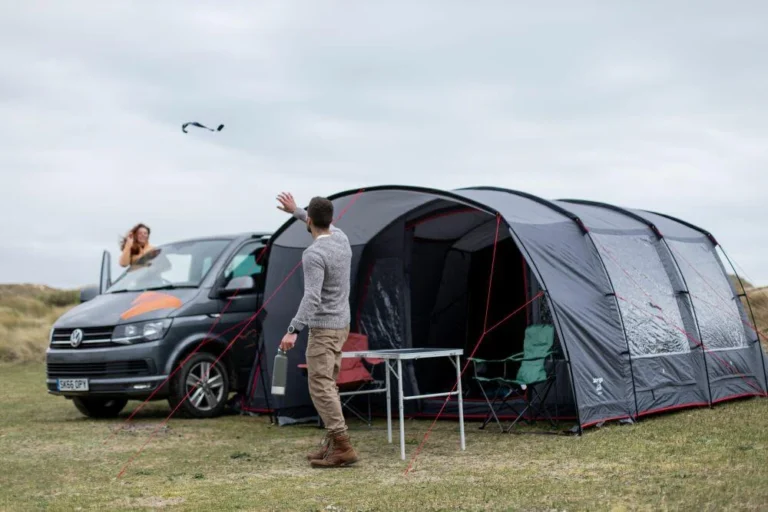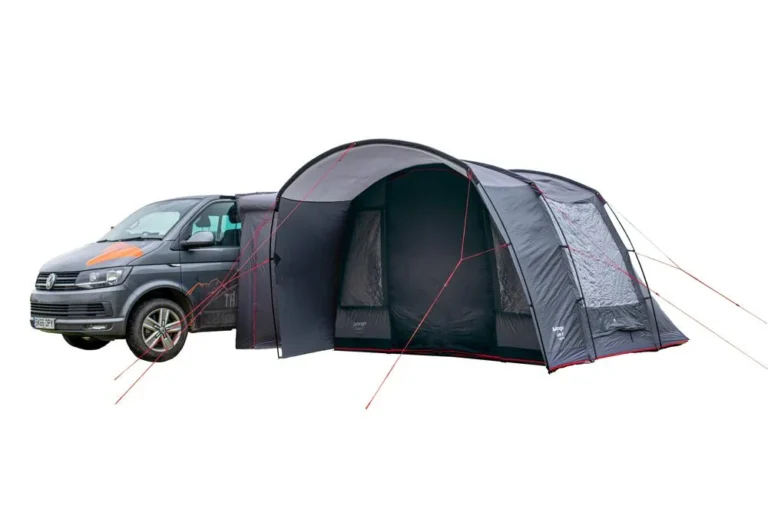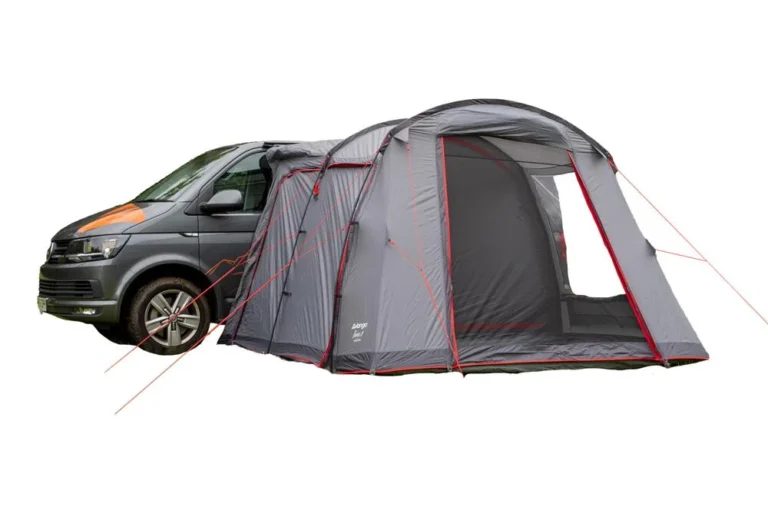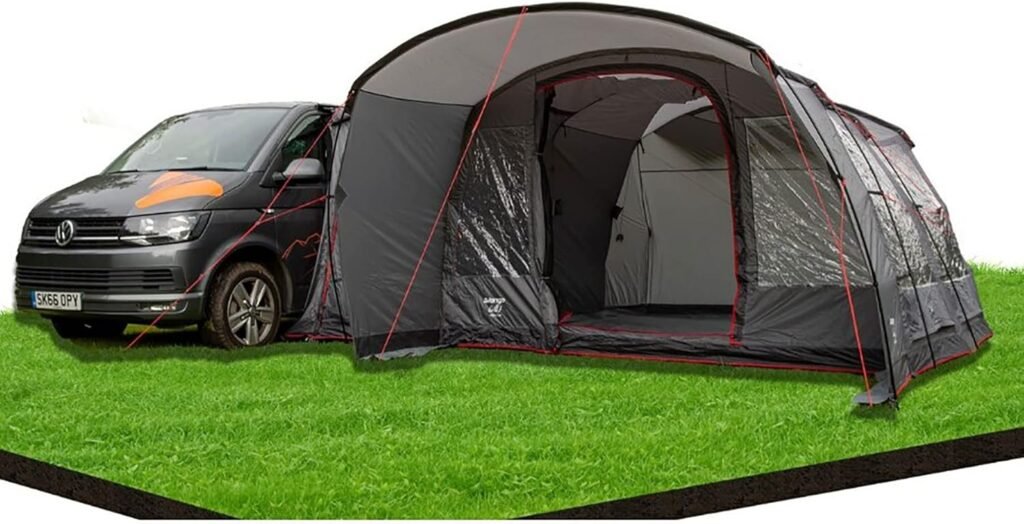
A Guide to Drive Away Awnings
Table Of Contents
Click here to jump to;
1. WHAT IS A DRIVE AWAY AWNING
3. HOW WOULD YOU USE YOUR DRIVE AWAY AWNING?
5. CHOOSING THE CORRECT HEIGHT AWNING
6. COMPARING POLED AND AIR AWNINGS
9. SUMMARY
Drive Away Awnings: Lets Get Into It
Looking at buying a drive away awning for your camper van or motorhome? Venturing into this market can seem overwhelming without the correct knowledge. Don’t worry though! In this comprehensive Campers Content guide, we will give you all the crucial details and essential information to ensure you make the right decision for your needs!
A drive away awning isn’t merely an accessory; it will completely transform your camping setup. While it may entail a significant initial investment, the advantages it offers to your outdoor excursions are immeasurable. Beyond providing extra living space, it allows complete adaptability and storage solutions, all without fixing your motorhome or campervan to a campsite.
For those seeking to optimize their camping endeavors, delving into the Campers Content drive away awning reviews is a must. Whether you’re a seasoned enthusiast or a novice to the camping scene, this guide will allow you to select the ideal drive away awning for you. Read the guide and ensure your next camping trip is a great one!
What Is a Drive Away Awning?
A drive away awning is composed of two primary elements, the main awning and the connecting panel. The connecting panel is specifically crafted to attach to the side of your motorhome or camper van. Notably, there are three predominant attachment height options: Low 180-210cm, Mid 210-245cm, and Tall 245-295cm. We will go into more detail about this later on in the guide.
Upon detachment, drive away awnings allow you to do exactly what they say! You can drive your vehicle away, leaving the standalone awning erected at the campsite! Thereby offering convenience and flexibility in your camping setup.
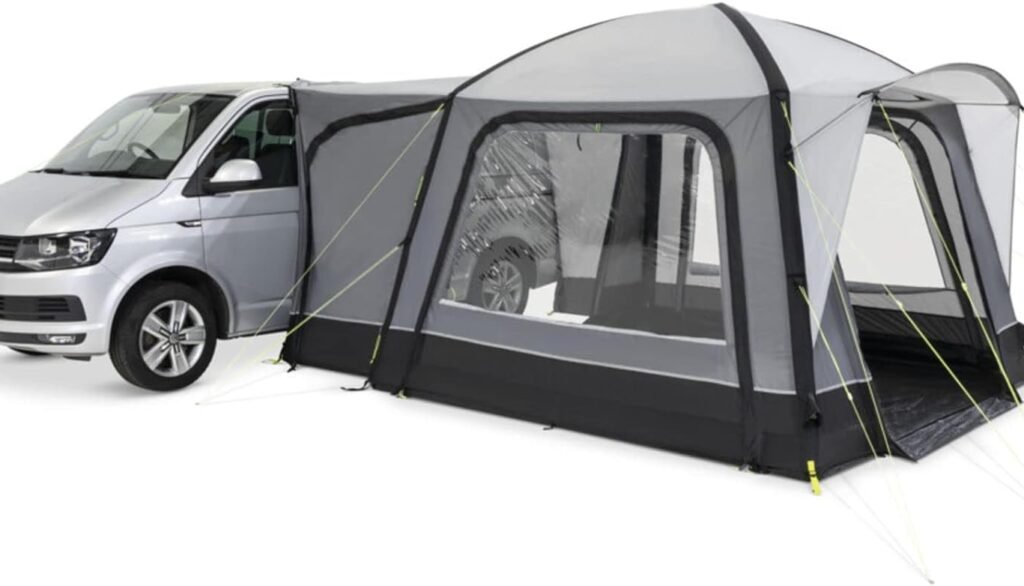
Why Consider Buying a Drive Away Awning?
Extremely Versatile – Drive away awnings significantly enhance flexibility for both camper vans and motorhomes, allowing you to get out and about without the hassle of taking down and re-pitching your awning!
Added Storage Capacity – By incorporating the awning into your setup, you’ll have far more storage space for those camping luxuries and essentials! Extremely helpful when space can be an issue inside campervans and motorhomes at the best of times!
Extended Living Space – Awnings serve as invaluable extensions to your living area! Again, when internal living room is limited these extensions provide comfortable areas for relaxation, clothing changes, and even cooking.
Extra Sleeping space – Most drive away awnings are equipped to accommodate either two or four berth inners, effectively boosting the sleeping capacity of your camping setup. So you can take your furry friends or invite friends and family along to enjoy the camping trips away!
How Would You Be Using Your Drive Away Awning?
Are you looking to extend your living space, create additional storage, or provide extra sleeping quarters for guests who might join you on a camping trip?
When reading the Campers Content reviews of the best drive away awnings on the market, it’s important to have in mind your main priorities of what you’re going to be utilising the awning for. The awnings we’ve reviewed offer a range of features, including the option to add sleeping compartments inside. However, keep in mind that some awnings are primarily designed for storage purposes. Remember this when reading our reviews to ensure you choose the awning with the correct features for your needs.
How Do You Attach The Drive Away Awning?
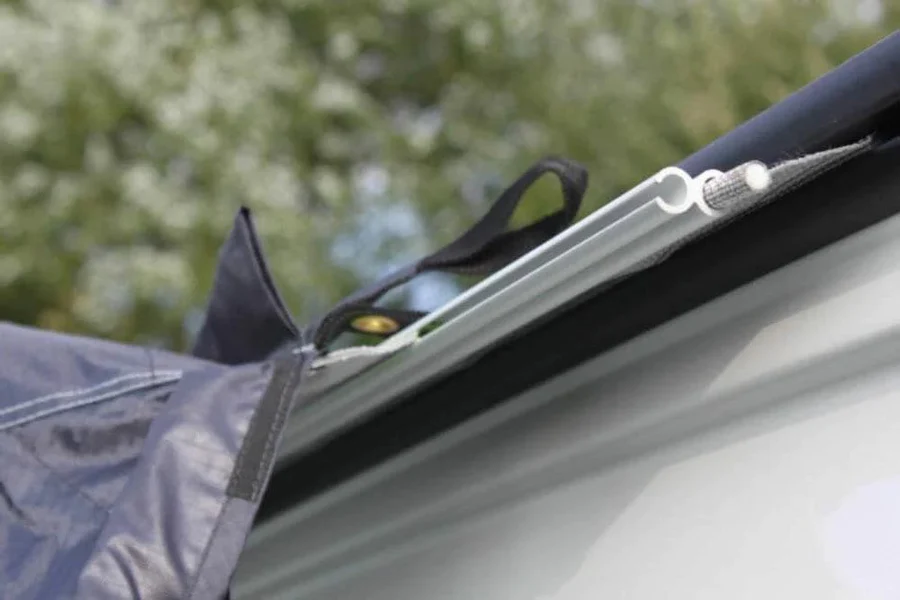
There’s four main options when it comes to attaching the drive away awning to your vehicle.
Pre-Attached Kador Rail: A lot of the awnings that we review come with a Kador strip attached to the connecting panel on the awning, allowing you to slide the kador strip into the side of your rail or C-Channel.
Pole & Clamp Kit: This method is ideal for older camper vans with a gutter. Simply thread the steel pole through the sleeve and use clamps to secure the awning to the gutter.
Storm Straps: Use storm straps that buckle into the awning. Secure the other end of the straps by pegging them down on the opposite side of your van or motorhome.
Velcro Tabs: If your vehicle has roof bars, the awning can be secured using Velcro tabs that attach to the roof bars.
What Height Drive Away Awning Should You Choose For Your Vehicle
When choosing an awning for your needs, it’s extremely important to take into account the height of the connecting panel. We’ve reviewed drive away awnings with three distinct awning heights to make it easy to choose the correct one for you. Each separate awning height is crafted to accommodate varying heights of campervans and motorhomes. While the overall dimensions and configuration of the awning remain consistent, the connecting panel is customized to fit different vehicle heights.
As a general rule of thumb, campervans typically require a Low awning, whereas motorhomes often require a tall or Highline variant. For those vehicles falling between the standard heights of camper vans and motorhomes, the mid or standard height awnings serve as an ideal solution. These awnings are tailored to suit the unique dimensions of such vehicles and ensure a seamless, snug fit.
Lets Have a Look At The Various Heights

Low/ Lowline 180- 210CM
The low awnings are designed around fitting a Volkswagen Transporter and any other vehicles of a similar height that fits in the 180- 210cm height range.
Mid/ Standard 205- 245CM
Most vehicles won’t fall under this category for drive away awnings however there is a few that do. When reading the Campers Content reviews, keep an eye out for the product specifications to make sure you choose the correct awning for your vehicle.
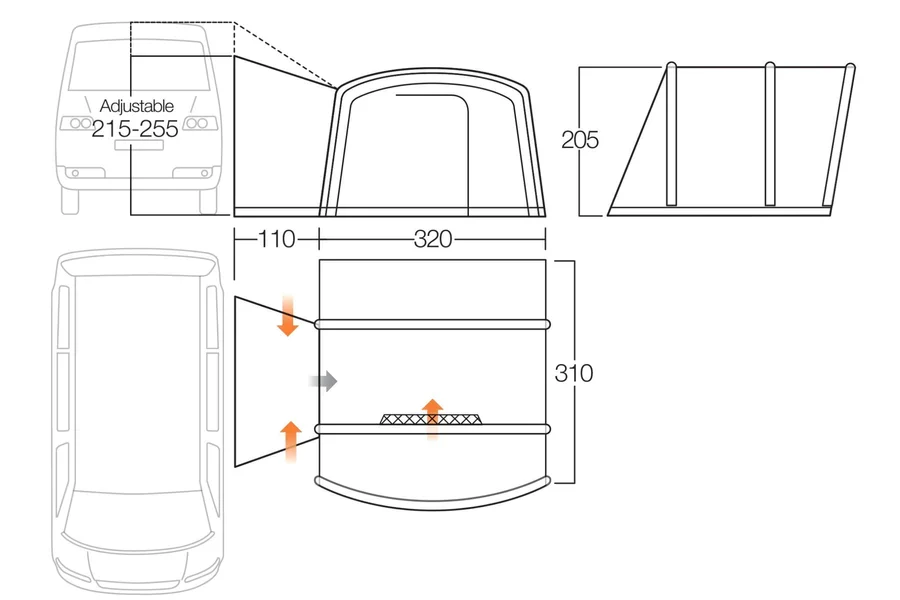
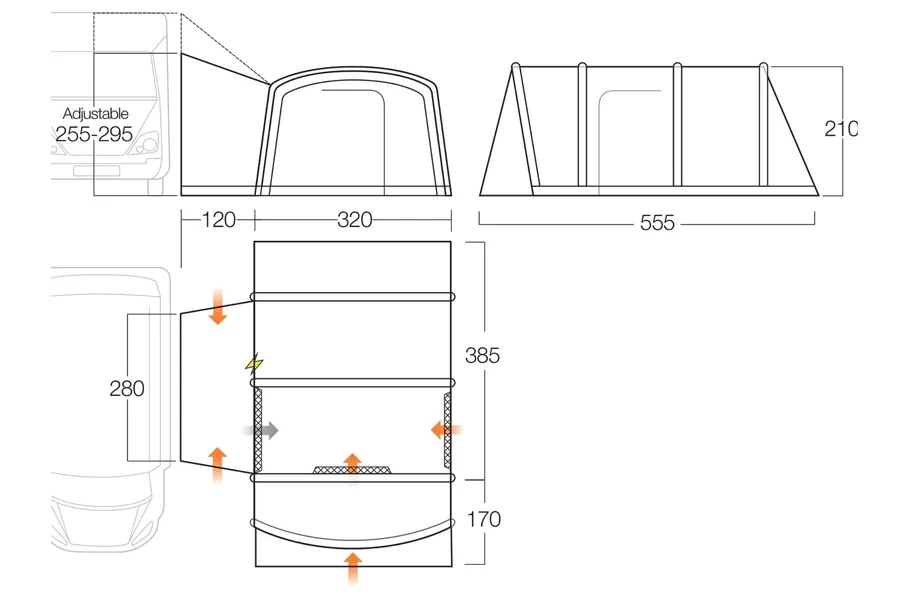
Tall/ Highline 245- 295CM
These drive away awnings are perfect for motorhomes and other vehicles that fit this height range. It’s also possible to purchase a ‘wind out rail’ that attaches to the side of the motorhome and makes the awning connection point easy to reach while connecting it up. Once connected the rail can be wound back in. We will go into more detail about these in the tall awning reviews.
What’s Better, Poled or Air Drive Away Awnings?
Just like tents, it’s possible to get both poled and inflatable air versions of drive away awnings. Here at Campers Content you’ll find reviews on both styles, so which should you choose?
Inflatable awnings possess the advantage of having air beams integrated into the awning. This simplifies the setup process as all you have to do is pump them up, which only takes only a few minutes! The innovative design allows you to be quickly doing what’s important, relaxing! Poled awnings obviously require the poles that are sprung joined. Just like a tent they have to be threaded through the pole sleeves. While this process is generally straightforward, it can occasionally be tricky and may take much longer to pitch, particularly for larger awnings.
Inflatable Awnings, or Air Awnings, typically have a larger pack size due to the inflatable bladders and additional fabric composing their air beams. They also come with a pump, which are all factors that collectively contribute to their weight being a lot heavier than the equivalent poled versions. The huge convenience of inflatable awnings does come with a trade off as well, as air awnings are generally pricier.
Styles of Drive Away Awnings
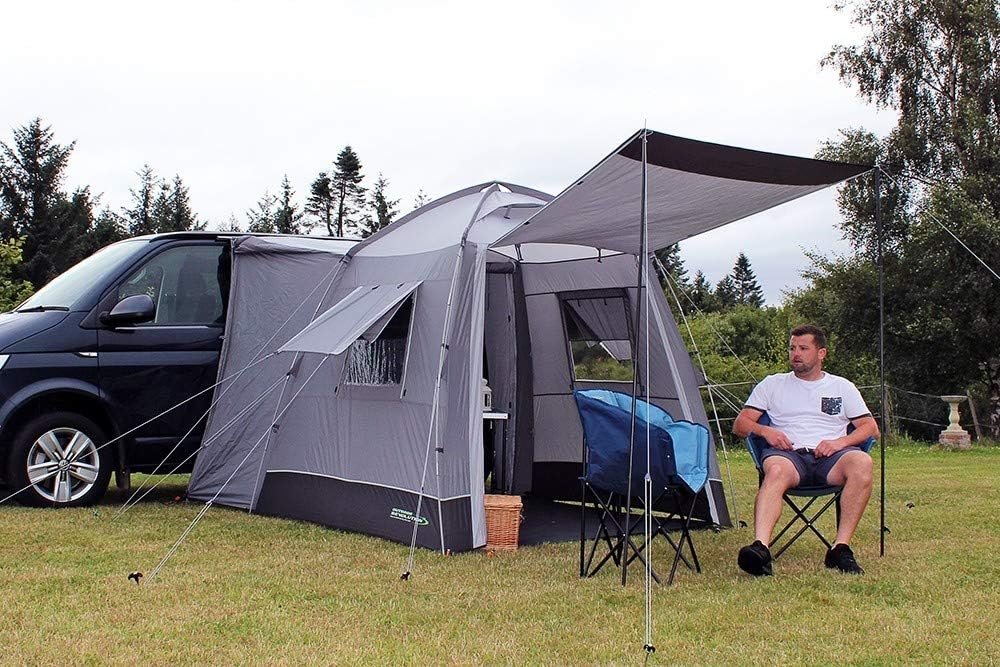
Side Facing Awning
One of the most common setups involves a side-facing awning. The main entrance door opens out from the side of the van, allowing occupants an unobstructed view when the sliding door is open. While this configuration offers great views on sites where parking direction is optional, it could potentially lead to facing directly toward neighboring pitches on campsites with designated hardstanding areas with pitches in close proximity.
The same model of side facing awning is adaptable to either side of the van, accommodating vehicles with both right-hand and left-hand sliding doors with equal ease.
Front Facing Awnings
A front facing awning is positioned alongside the van, providing a connection panel to its side. They offer ample space and are highly adaptable for attaching sleeping pods.
When opting for a front facing awning, it’s crucial to choose the appropriate type that aligns the connecting panel with the correct side of the vehicle. Most awnings will fit a vehicle with the sliding door left side (UK passenger side) but it is definitely worth checking the specifications. Some awnings are attachable on both sides of a vehicle either because they’re symmetrical or the will face to the rear on the opposite side.
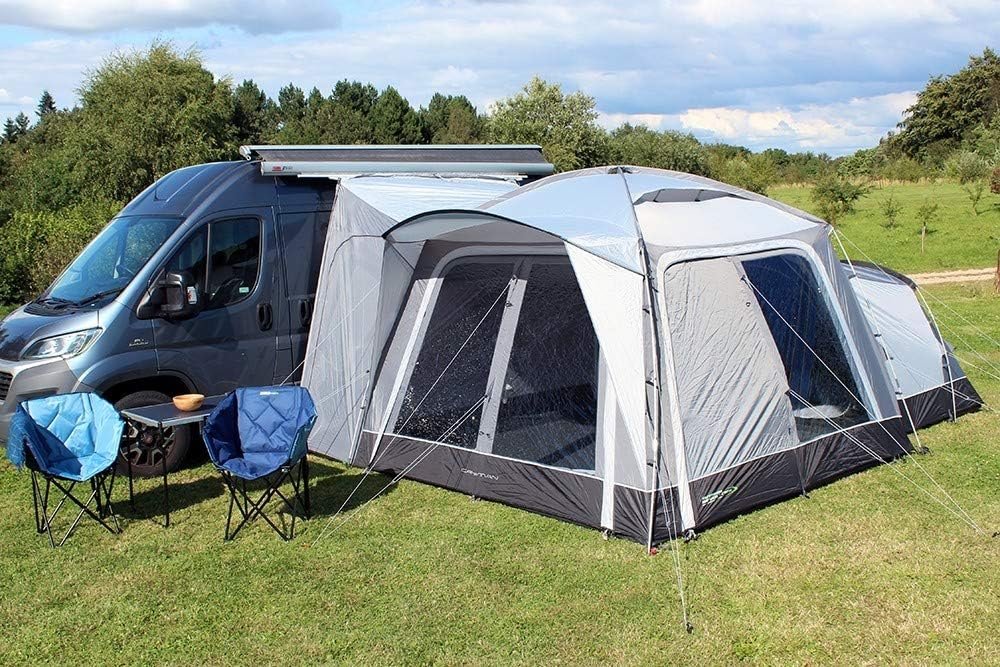
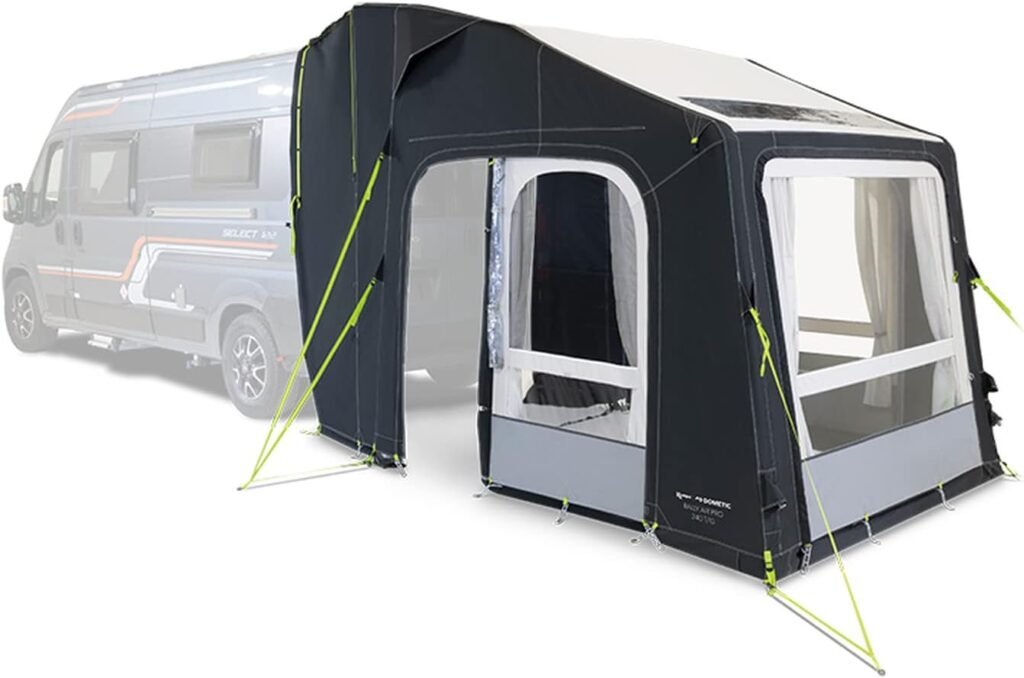
Rear Facing Tailgate Awnings
These attach to the rear of a vehicle with hook on webbing straps and/ or peggable guylines. Rear facing awnings can be connected to vans with barn doors as well as tailgates. These awnings make up a very small segment of the awning market and generally appeal to van owners with a specific internal van set up such as a tailgate kitchen for instance.
Rear facing awnings can sometimes be a problem on campsites with set pitch sizes because of the length when connected to a vehicle.
Drive Away Awning Fabrics
When reading the specifications look out for this words:
Denier– this is the unit measuring the weight and thickness of the individual threads used in the fabric. Fabric with a higher Denier will be thicker, stronger and more durable than the same fabric with a lower Denier
Hydrostatic Head– is the measurement of how waterproof a fabric is. For the UK a 2000mm rating is easily enough for the worst downpours. Anything above 3000mm hydrostatic head can handle pretty much any rain Europe can throw at it.
Polyester, Lightweight Touring Awnings
Polyester fabric is commonly used in the production of drive-away awnings due to its lightweight and compact nature, making it ideal for touring campers. It offers convenience and portability.
70 Denier
This entry-level fabric is suitable for shorter camping trips during the summer season.
150 Denier – 150 Denier: A balance between quality and weight, the 150 denier polyester fabric is thicker and stronger. It is perfect for those seeking an easily pitched awning with durable fabric.
Double-Ripstop Polyester/ Heavy Duty Awnings
These awnings are known for their strength and are particularly suitable for campers venturing out during early or late camping seasons. The fabric’s durability is significantly higher, ranging from 420 Denier to 600 Denier, making it 245% stronger than 70 Denier polyester fabric.
Polycotton Fabric
Polycotton fabric is better suited for campers in colder or hotter climates as it adapts to the weather conditions. It offers enhanced durability, making it an excellent choice for long-term camping.
Ideal for Hotter Climates: Polycotton fabric breathes, making it perfect for use in hotter climates.
Naturally Waterproof: The fabric is inherently waterproof and adjusts to varying weather conditions.
Ground Sheets
Just like tents, built in groundsheets are a feature on most drive away awnings and provide a more contained and draught-free environment. Most also come with high and low level mesh vents for air circulation. If it is really important to you that your awning is completely sealed at ground level lookout for the term ‘Full Zip Around’ as although some drive-away awnings have sewn in groundsheets they may not completely seal along the bottom of all the entrance doors.
Some people prefer a linked in groundsheet that can be removed by simply unclipping it at the corners and edges. This can be a good option on a hard standing pitch or in dry conditions where you want nature underfoot or in wet conditions where you do not want to be treading mud through your awning.
Whichever type of groundsheet option you choose, you will notice additional groundsheet protectors or footprints available which are for protecting the main groundsheet on sharper surfaces such as gravel or hardstanding and help packing away the awning in a clean condition.
Summary
A drive-away awning is a fantastic way to make your campervan or motorhome more spacious, organized, and adaptable. There are many options available, so you can easily find one that suits your needs and budget.
Read the large range of Campers Content reviews on the best drive away awnings today. We only review the best products on the market from trusted brands like Vango, Outdoor Revolution, and Kampa so finding the perfect awning for you couldn’t be easier.
Thanks for reading this guide to drive away awnings! We hope its helped!
View our Reviewed Awnings here
DISCLAIMER– This post may contain affiliate links, which means if you purchase the product I’ve reviewed using the link provided I’ll receive a small commission at no extra cost to you. Writing product reviews takes time, so this way it will help me to continue writing about products I believe in long into the future! Thank you !

